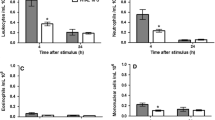Abstract
The participation of mast cells in connective tissue repair was studied using the perforated-rat-mesentery model. Perforation of mesenteric membranes was performed during laparotomy of anesthetized Sprague-Dawley rats. Laparotomy significantly reduced the histamine content of the mesenteric membranes on day 1 postoperatively and perforation as such reduced the histamine content even more on days 1–10. Mast cell activation induced by a single intraperitoneal injection of Compound 48/80 two days prior to operation, significantly improved healing on days 5–7 postoperatively. Daily injections of Compound 48/80 for 5 days prior to operation showed significantly better healing compared to such injections for five days postoperatively. Administration of lupitidine, a long acting histamine H2-receptor antagonist, two times daily starting on the day of 48/80 injection to day 4 after operation did not apparently affect healing.
The results indicate that mast cells may be activated during normal wound healing and that a preoperative, pharmacological activation improves healing. Furthermore, histamine does not seem to be of major importance for the beneficial effect of such mast cell activation on connective tissue repair.
Similar content being viewed by others
References
L. Franzén,Mast cell secretion and connective tissue cell proliferation. Linköping University Medical Dissertations97 (1980).
K. Norrby, L. Enerbäck and L. Franzén,Mast cell activation and tissue cell proliferation. Cell. Tiss. Res.170, 289–303 (1976).
K. Norrby, A. Jakobsson and J. Sörbo,Mast-cell-mediated angiogenesis: a novel experimental model using the rat mesentery. Virchows Arch. [Cell Pathol.]52, 195–206 (1986).
M. Clinton, W. F. Long, F. B. Williamson, J. I. Duncan and W. D. Thompson,Effect of the mast cell activator compound 48/80 and heparin on angiogenesis in the chick chorioallantoic membrane. Int. J. Microcirc: Clin. Exp.7, 315–326 (1988).
D. W. Fitzpatrick and H. Fisher,Histamine synthesis, imidazole dipeptides and wound healing. Surgery91, 430–434 (1982).
A. Schittek, A. A. Demetriou, J. Padawar, E. Seifter and S. M. Levenson,Compound 48/80 and the healing of wounds in rats. The effect of timing of drug injections. Agents and Actions4, 173–176 (1984).
H. W. Whitting,The tissue mast cell and wound healing. Int. Rev. Gen. Exp. Zool.4, 131–168 (1969).
B. Wichmann,The mast cell count during the process of wound healing. Acta Path. Microbiol. scand. [Suppl.]108, 1–35 (1955).
S. Yoshida, L. Flancbaum, J. C. Fitzpatrick, R. A. Berg and H. Fisher,Effects of compound 48/80 and exogenous histamine on wound healing in mice. PSEBM191, 90–92 (1989).
C. W. Kischer, H. Bunce and M. R. Shetlar,Mast cell analyses in hypertrophic scars, hypertrophic scars treated with pressure and mature scars. J. Invest. Dermatol.70, 355–357 (1978).
W. C. Udoji and S. A. Razavi,Mast cells and myelofibrosis. Am. J. Clin. Pathol.63, 203–209 (1975).
L. Franzén and K. Norrby,A tissue model for quantitative studies on time course of healing, rate of healing, and cell proliferation after wounding. APMIS91, 281–289 (1983).
L. Enerbäck, L. Franzén and K. Norrby,A tissue model for the study of cell proliferation parameters in vivo. Histochemistry47, 207–218 (1976).
L. Enerbäck and U. Wingren,Histamine content of peritoneal and tissue mast cells of growing rats. Histochemistry66, 113–124 (1980).
L. Franzén,Further studies on the relationship between drug-induced mast-cell secretion and local cell proliferation. Acta Path. Microbiol. Scand. Sect. A89, 57–62 (1981).
O. H. Lowry, N. J. Rosenbrough, A. L. Farr and R. J. Randall,Protein measurement with the folin phenol reagent. J. Biol. Chem.193, 265–275 (1951).
M. Eisinger, S. Sadan, R. Soehnchen and I. A. Silver,Wound healing by epidermal-derived factors: experimental and preliminary clinical studies. In:Growth factors and other aspects of wound healing: biological and clinical implications. pp. 291–302 (Eds. A. Barbul, E. Pines, M. Caldwell and T. K. Hunt). Alan R Liss, New York 1988.
I. A. Silver and M. Eisinger,Influence of an epidermal cell extract on skin healing and scar formation. Int. J. Tiss. Reac.X (6), 381–385 (1988).
L. Franzén and K. Norrby,Mitogenesis in wound healing cells in diabetic rats. APMIS96, 519–524 (1988).
L. Franzén and M. Ågren,The effect of zinc deficiency on connective tissue repair in the perforated rat mesentery. J. Trance Element Exp. Med. (Submitted for publication).
L. Franzén, P. Adamson and K. Norrby,Increased angiogenesis during wound healing in rats with streptozotocin-diabetes. Int. J. Microcirc: Clin. Exp.9, 401–410 (1990).
K. Norrby and L. Franzén,Time course and rate of healing after wounding the avascular mesentery in diabetic rats. APMIS92, 411–416 (1984).
D. A. A. Owen,Inflammation—histamine and 5-hydroxytryptamine. British Med Bull.43, 256–269 (1987).
G. Kahlson and E. Rosengren,New approaches to the physiology of histamine. Physiol. Rev.48, 155–195 (1968).
N. Sandberg,Influence of antihistamine and Compound 48/80 on healing. Experentia31, 580–581 (1975).
K. Norrby, Mast cell histamine, a local mitogen acting via H2-receptors in nearby tissue cells. Virchows Arch. B Cell. Path.34, 13–20 (1980).
R. C. Blakemore, T. H. Brown, G. J. Durant, C. R. Ganellin, M. E. Parsons, A. C. Rasmussen and D. A. Rawlings, SK&F 93479, a potent and long acting histamine H2-receptor antagonist. Br. J. Med.74, 200 (1981).
D. M. Goldman, S. Bark, S. M. Levenson and A. U. Demetriou,Effect of cimetidine on wound healing in rats. Agents and Actions19, 1–4 (1986).
L. Franzén and K. Norrby,Local mitogenic effect of tissue mast cell secretion. Cell. Tissue. Kinet.13, 635–642 (1980).
K. Hatanaka, M. Imakita, S. Go and A. Yamamoto,Effects of degranulation of mast cells on proliferation of mesenchymal cells in the mesentery of mice. Cell Tissue Res.246, 53–56 (1986).
G. Gabbiani, B. J. Hirschel, G. B. Ryan, P. R. Statkov and G. Majno,Granulation tissue as a contractile organ. J. Exp. Med.135, 719–734 (1972).
L. Franzén,Occurrence of myofibroblasts during wound healing in the perforated rat mesentery. J. Ultrastruct. Mol. Res.100, 298–299 (1988).
S. J. Leibovich and R. Ross,The role of macrophage in wound repair: a study with hydrocortisone and antimacrophage serum. Am. J. Pathol.78, 71–100 (1975).
Author information
Authors and Affiliations
Rights and permissions
About this article
Cite this article
Franzén, L., Ghassemifar, R. & Malcherek, P. Experimental mast cell activation improves connective tissue repair in the perforated rat mesentery. Agents and Actions 33, 371–377 (1991). https://doi.org/10.1007/BF01986588
Received:
Accepted:
Issue Date:
DOI: https://doi.org/10.1007/BF01986588



